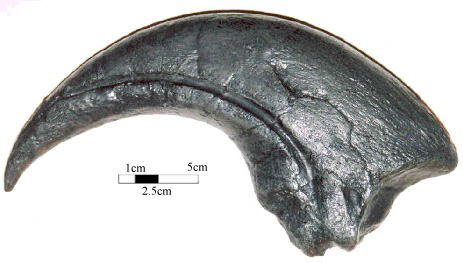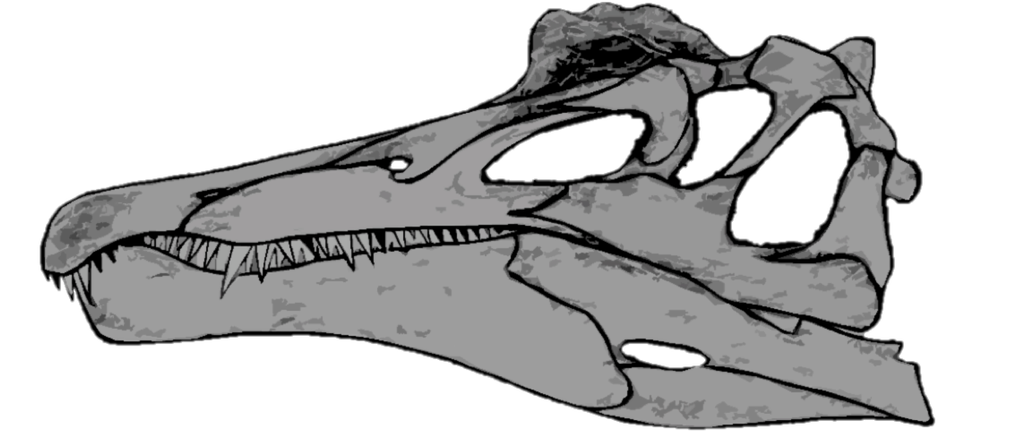 |
| The claw of Baryonyx walkeri |
A dig was subsequently conducted to recover as much of the creature as possible and in 1986 a new species of dinosaur was named: Baryonyx walkeri. With a long, slender snout and hooked thumb claw, Baryonyx was unusual in that it was a water-dwelling dinosaur, inhabiting shallow rivers and lakes, using its anatomical hook to catch fish.
Until 1998, Baryonyx was the only known dinosaur to have led such a lifestyle, then came Suchomimus. Now they are joined by a third semi-aquatic oddity: Spinosaurus, adding another piscivorous dinosaur to the tree of life. Larger than Tyrannosaurus rex with a sail along its spine and rather crocodylian jaws, it is a children's favorite, but books usually depict Spinosaurus as a hunter on land. A few, however, dared to suggest that it lived otherwise, in a fashion similar to Baryonyx stalking shallow lakes and rivers. This view attracted a fair amount of flak from the palaeontological community, but recently it has gained momentum, thanks to a paper on the dinosaur's anatomy to be published this year.
 |
| A diagram of the skull of Spinosaurus, indicating the position of the nostrils in the middle of the skull |
The nostrils were the first indicator, placed in the middle of the dorsal side of the skull rather than on the tip of the snout, allowing them to remain high and dry even if the rest of the creature was submerged. What is more, the shape of the neurovascular opening at the end of the snout was incredibly similar to those found in crocodiles and alligators - water-dwelling reptiles - suggesting that they evolved to suit a similar aquatic lifestyle.
The teeth and thumb claws pointed to the same conclusion, being ideal for catching slippery fast-moving prey. Whilst the long-boned feet and toe claws would have been more suited for walking across soft sediment in a river or lake rather than high speed pursuit on land. Finally, its general anatomy would have conveyed significant advantages in water rather than on land. Dense bones, lacking the cavities seen in its close relatives, would have given it supreme control over its buoyancy. Whilst a long neck and trunk would have shifted its central mass forward, causing problems for terrestrial mobility, but facilitating easy movement in water.
Similarly a small pelvis and short, muscular hind limbs were not conducive to supporting its weight on land, but would have been far better suited to propelling Spinosaurus, whilst its bulk was supported, in water. The loosely connected bones in the tail would have allowed it to flex from side to side, like the tail of a fish, which would have aided propulsion. Finally there was the large dorsal sail supported by thin rods of bone supporting a thin web of skin and blood vessels. It has been argued that this was used to trap heat to help keep the dinosaur's metabolism ticking over. However, the density of the bone combined with few blood vessels suggests that it was not used to trap heat or store fat.
It is more likely this was used as a mating display, the dinosaur flushing blood into the structure to create vivid colours and patterns to attract females or intimidate rival males. As this sail would have remained above the surface no matter how deep Spinosaurus waded, it would still have served as an efficient means of signalling. Overall a picture emerges of a thoroughly unique species. 'Working on this animal was like studying an alien from outer space; it's unlike any other dinosaur I have ever seen,' said Nizar Ibrahim, lead author of the paper.
 |
| A digital reconstruction of Spinosaurus in a swimming posture |
Ibrahim had to painstakingly track down the localities where each Spinosaurus fossil had come from, including a partial skeleton collected by a local hunter who had failed to record where he had unearthed it - a great sin in palaeontology and an example which highlights the importance of allowing research professionals to conduct digs.
Locating a specific fossil hunter in Morocco is nigh impossible, considering that it is one of the fossil capitals of the world, selling everything from Ordovician trilobites to Cretaceous dinosaurs across the country. Ibrahim was able to track down the original collector and establish the location where the specimen was found.
Armed with this information the researchers identified precisely the environment in which Spinosaurus lived. 100 million years ago North Africa was covered in a series of waterways and shallow seas: home to a plethora of fish from coelacanths to sharks. There were few terrestrial herbivores. Therefore the most abundant food source were marine organisms. The evidence slots together neatly to provide an image of Spinosaurus as an aquatic predator - testament to the fact that there is always something to learn from species we have known about for hundreds of years.